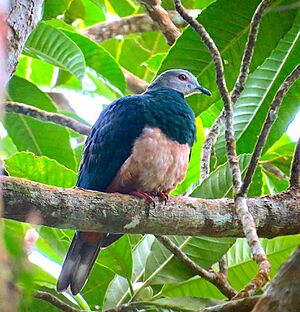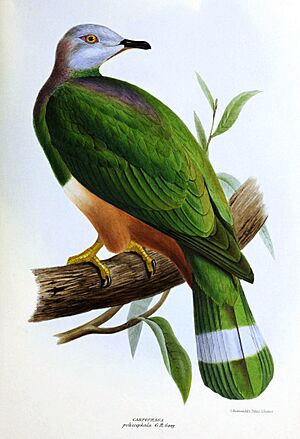Pink-bellied imperial pigeon facts for kids
Quick facts for kids Pink-bellied imperial pigeon |
|
|---|---|
 |
|
| Conservation status | |
| Scientific classification | |
| Genus: |
Ducula
|
| Species: |
poliocephala
|
The pink-bellied imperial pigeon (Ducula poliocephala) is a cool bird found only in the Philippines. It's also sometimes called the zone-tailed pigeon. This large bird loves to eat fruit and can grow up to 42 centimeters long!
This pigeon is mostly dark green. It has a pale gray head and, as its name suggests, a pink belly! Its tail has a mix of brown, black, and gray patterns. You can spot its red eyes and red eye ceres (that's the skin around its eyes). Sometimes, these pigeons hang out with other big doves.
Contents
What Does the Pink-Bellied Imperial Pigeon Look Like?
This pigeon is quite big. It has a white head and a dark bluish-gray chest and upper back. Its wings are green. Its belly is whitish with a pink tint. You might also see some reddish-brown color under its tail.
A special feature is its large red ring around its eyes. This bird looks a bit like the Mindoro imperial pigeon. But the pink-bellied pigeon has a darker neck and chest.
You can often hear its song. It sounds like a deep, booming "doo-dup! doo-dup!" This call can be heard from far away. These pigeons are strong fliers. They can even fly between different islands!
Where Does This Pigeon Live?
The pink-bellied imperial pigeon lives in tropical moist lowland forests. It also lives in montane forests, which are forests found on mountains. You can find them up to 1,500 meters high.
Why Is This Pigeon in Danger?
The IUCN Red List helps us know which animals are in danger. It says the pink-bellied imperial pigeon is a Near-threatened bird. This means it could become endangered soon.
However, the Philippine Red List says this bird is Critically Endangered. This is a very serious level of danger. There are a few reasons why this pigeon is in trouble.
Threats to the Pink-Bellied Imperial Pigeon
- Habitat loss: People are cutting down the forests where these birds live. This means they lose their homes and food.
- Trapping for the pet trade: Some people catch these pigeons to sell them as pets.
- Hunting for food: These birds are also hunted for food in some areas.
Even though this pigeon lives in many parts of the Philippines, it's not very common. Its population is getting smaller quite quickly. This is mainly because of hunting and losing its forest home.
The pink-bellied imperial pigeon is very rare on Luzon island. But you can see it more often on Negros Island, Mindoro, Samar, and Mindanao. Sadly, it no longer lives on Cebu island.



